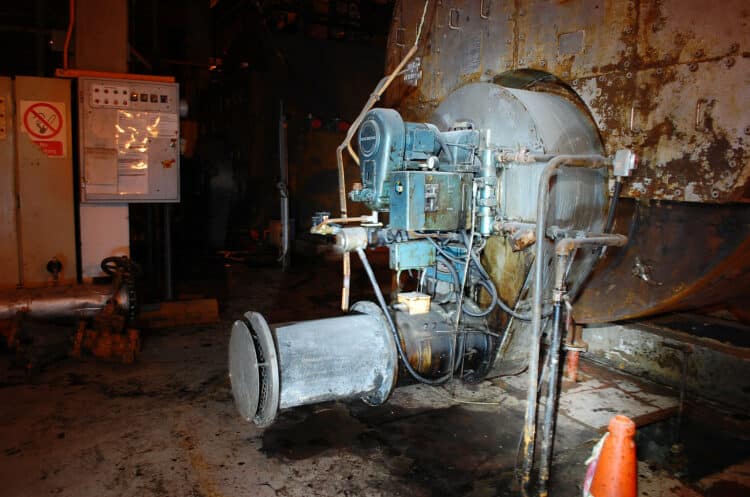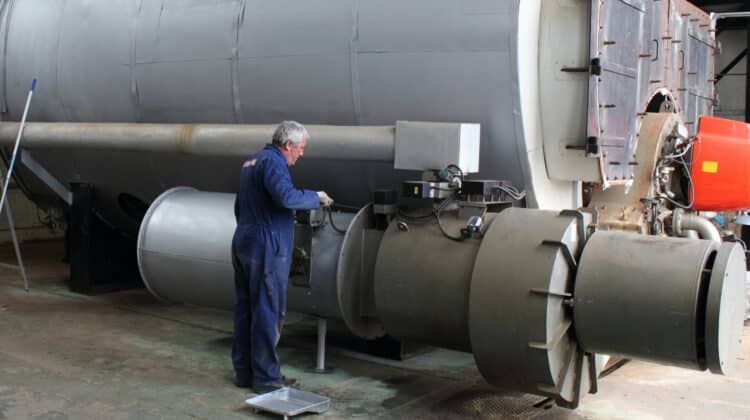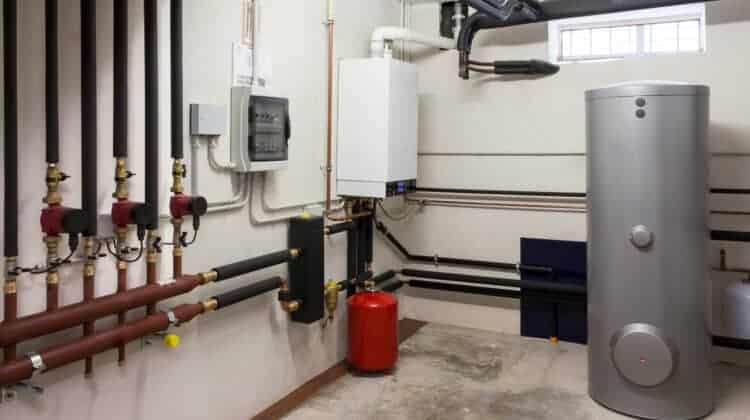
The boiler is the beating heart of every heating system. Its job is to generate and transmit hot water or steam to radiators that heat our homes.
Selecting the most appropriate boiler for your home will keep you and your family cozy for years. And keep energy costs down as low as possible. Several factors come into play when choosing the perfect boiler. Please read our guide to find out more.
Table of Contents
Hot Water or Steam Boiler?
Boilers typically create steam or hot water to heat your radiators. Before deciding on which type to buy, it is essential you accurately determine the heating needs of your home.
If you are unsure which kind of boiler would be best, we would suggest you consult with a professional. However, you can find clues to help determine whether you should get hot water or a steam boiler.
First, check your radiators. Regardless of whether the radiators are panel, baseboard, or cast iron, they will all have an air vent if it is a steam system. This valve lets air escape and steam flow into the radiator.
Check, too, how many pipes are connected to the radiator. Steam systems almost always have just one pipe. Radiators with two pipes could be steam, but more likely hot water.
If your home has underfloor heating, it is almost a certainty that you have a hot water system.
If you draw a blank with your radiator inspection, you should then check your boiler to determine your type of heating system. Steam boilers have a tell-tale sight glass attached to the boiler housing, usually on the side. The sight glass is a small tube used for checking the boiler’s water level.
If you don’t have a sight glass, you have a hot water boiler. Other signs of a hot water boiler are nearby auxiliaries like an expansion tank or a pump. Bear in mind that with many older hot water system models, the expansion tank may be in the attic. Some older systems did not have a circulator pump either.
If you still can’t tell which system you have after inspecting the radiators and boiler, please contact a professional to check for you.
Which type of fuel?
Nowadays, there are several boiler fuels to choose from, including electricity, oil, natural gas, liquid propane, and biomass.
Electricity
Electric boilers are a popular choice, particularly in areas where other fuels are difficult to source or too expensive. Electric boilers are well suited to small applications like putting heat into a garage, for instance.
Oil
In areas where natural gas is not on tap, oil has become commonplace, especially in northeast states and eastern parts of Canada.
An oil-burning boiler will require a tank installed on your property. You will also need to arrange regular oil deliveries to ensure you don’t run out.
Natural Gas
Urban areas tend to favor natural gas as a fuel source. This is because it’s easy to get a gas connection into your home from the utility main.
Propane
Areas that have no mains natural gas usually opt for liquid propane. Like oil-burning boilers, a propane-powered boiler requires a fuel tank to be installed on your property. The tank can be situated above or below ground. As with oil, you will need periodic propane deliveries to keep your boiler running. Interestingly, many natural gas-fired boilers can be converted to propane with a conversion kit. It’s also possible to convert from propane to natural gas.
Biomass
Another fuel option, especially in rural areas, is a biomass boiler. These boilers burn wood, coal, or other solid biomass, to produce heat. The main downside is that this type of boiler needs to be loaded with its fuel source manually whenever you require heat. In regions where there’s easy access to biomass, these boilers can produce significant savings. However, you will often find that a conventional oil or propane boiler is installed as a backup. Either for when there is no biomass available or no one is around to fuel up the biomass boiler.
Venting Options
As with any engine involving internal combustion, a boiler system needs a way to release combustion gases. There are three typical venting options; chimney, direct venting, which is essentially sealed combustion, and power venting, a direct exhaust.
Choosing the best option for the home depends on three main factors; your current boiler type, your home construction type, and the efficiency you wish to obtain from a new boiler.
As suggested by the name, chimney venting lets the boiler eject exhaust gas via a vertical cylinder. The chimney’s specification – including height, width, and construction – varies by the boiler model.
You can only be certain if a particular chimney is suitable for your boiler by having the chimney inspected by a certified professional.
Chimney venting hinges on the fact that hot air rises because it is not so dense as cold air. Being hot and lighter, the combustion gas travels up the chimney at the same time as fresh air is pulled in to continue the combustion in the boiler.
As this process relies on the passive rules of nature rather than combustion gas being forced out by a fan, a chimney obstruction will significantly disrupt your boiler’s operation. A chimney blockage or insufficient fresh air supply can potentially cause a fire or deadly carbon monoxide to leak into your home.
For homes with no existing chimney, a chimney in disrepair, or one that’s not compatible with the boiler, power venting is a good alternative.
Power venting, or direct exhaust as it is also known, involves an integral blower pulling in fresh air for boiler combustion and pushing out spent exhaust gases.
Power venting gives you added flexibility as you can vent via a side wall or ceiling without a chimney stack. The built-in blower also means vent piping can be significantly smaller and less obtrusive. This benefit is because air is being actively moved through the boiler and therefore does not require the same vent piping size as a chimney system.
Power venting boilers draw fresh air from inside your home, so there must be a sufficient fresh air supply to guarantee correct boiler operation.
Direct venting, meanwhile, is sometimes referred to as sealed combustion. This boiler type is ideal for modern, draft-free homes.
Unlike chimney and power venting, direct venting draws fresh air for the boiler from outside the home. The exhaust gases also go straight back outside. In other words, the entire combustion and exhaust process is sealed from the home. Plus, you’re not pushing heated exhaust gas back into your environment.
In contrast, chimney and power venting draw air from inside your home for the combustion process. The optimal operation of the boiler relies on there being an adequate fresh air supply inside your home.
Because direct venting is not drawing air from inside your home, this boiler type can usually be installed in confined spaces or closets. Their exhaust system can go through a side wall or a ceiling and uses smaller gauge pipes similar to power vented-boilers.
As we can now see, direct vented and power vented boilers have to be directly vented outdoors. They cannot be used in conjunction with a chimney or with conventional systems and appliances that need chimney venting.
Fuel Efficiency
Boilers are usually sold with an Annual Fuel Utilization Efficiency rating of between 80 to 96%. This AFUE rating is an estimate of the percentage of fuel a home boiler can successfully convert into usable heat. A comparison of AFUE ratings will give you a rough idea of how expensive a boiler will be to run.
Standard efficiency for a boiler is typically regarded as an efficiency rating ranging from 80 to 84%. In this bracket, most boilers will be using a heat exchanger made from cast-iron along with chimney venting. Some models are also available that use power and direct venting.
This class of boiler is designed to only meet the minimum federal levels for fuel-efficiency. Generally, they do not qualify for fuel-efficiency rebates or incentives. However, their main selling point is that they are relatively cheap and use standard venting techniques.
Due to their long-running design and construction, separating boilers in this segment is difficult. Picking out a boiler that’s the correct size for your home and one that your installer is familiar with is the best route to efficiency and reliability from a standard efficiency boiler.
However, several manufacturers also sell ‘high efficiency’ variants of their standard efficiency chimney-vented models. But this label is somewhat misleading. What has happened is that the ignition characteristics have been tweaked to obtain an AFUE rating of more than 85%. Often this is at the expense of output and running costs. The sole purpose of these ‘high efficiency’ versions is to qualify for the applicable rebates and incentives offered by specific regions and utility companies.
As well as increased upfront costs, AFUE boilers ranked at 85% frequently require expensive stainless steel venting. On balance, we would suggest giving these models a body swerve unless your area has a rebate that will offset the increased outlay.
The benchmark for high-efficiency boilers is an AFUE rating that exceeds 90%. In this segment, boilers will typically be fitted with aluminum or stainless steel heat exchangers as the best compromise on efficiency and lifespan.
Almost all high-efficiency boilers use direct venting. However, some models can be converted to power venting. The venting materials often differ from standard boilers but are significantly cheaper than the stainless steel that’s frequently required by 85% AFUE units.
High-efficiency boilers are undeniably more expensive to buy and subject to much stricter installation requirements than standard models. You must examine this against the fact that these boilers can provide substantial savings of around 30% and are kinder to the environment.
Condensing boilers
High-efficiency boilers use a condensing process to get the maximum heat delivered around your home. This process involves the chemistry behind combustion and the resulting energy to condense water vapor.
Often condensing boilers can achieve 10% better efficiency than non-condensing units. However, they are more suitable in particular applications than in other circumstances.
Condensing boilers are relative newcomers to the market but are becoming quite commonplace today. The main reason is that conventional systems with baseboard or cast-iron heaters do not maximize their design. Non-condensing boilers were designed to work with very hot water, around 180° F. By comparison, condensing boilers are designed to work with water temperatures below 140° F.
The good news is that condensing boilers are compatible with high-temperature systems. But crucially, they still perform better than conventional boilers in this scenario, albeit some of the benefits are lost.
Newer heating types like underfloor and panel radiator systems are well suited to condensing boilers. These two systems, particularly underfloor, operate with lower water temperatures, maximizing a condensing boiler’s efficiency.
A non-condensing boiler can also be used for panel radiator and underfloor heating but will require modification with a mixing device to lower temperatures. Condensing boilers, therefore, are always going to be the better option as they are more efficient. It does not matter the kind of application, but in lower water temperature systems, especially, a condensing boiler’s efficiency will be maximized.
Staging and modulating boilers
As their name indicates, staging boilers heat homes using two distinctive heat levels called stages. The boiler is fine-tuned to operate at the lowest level possible to meet your home’s heating demands. This ability ensures the boiler operates smoothly and delivers an even amount of heat. The outcome is that a staging boiler burns less fuel than a straightforward on or off boiler without staging.
Meanwhile, modulation is a means of control, enabling the boiler to operate at a range of preset minimum and maximum heat outputs. This flexibility allows finer heat management than you get with a staging boiler, resulting in consistent heat levels.
By continuously fine-tuning your home’s heating, a modulating boiler will provide a near-constant temperature and significantly reduce fuel consumption.
Though staging is a rarity in home heating systems, modulation controls are frequently found on high-efficiency condensing boilers.
While staging is rare in residential applications, modulating controls are often built into high-efficiency condensing boilers.
Combining staging and modulation, together with robust heat management controls, high-efficiency condensing boilers provide unrivaled efficiency, performance, and home comfort.
Sizing Up Your Boiler
Despite all the fantastic technology available today, no boiler can provide efficiency and consistent heat if it is not the correct size for your home. Suppose you’re replacing an existing boiler, and you were happy with its output. In that case, you can use its size as a rough guide for your replacement boiler.
However, getting the calculations correct is tricky, so it is always best to get a professional to work out the perfect boiler size for your home.





